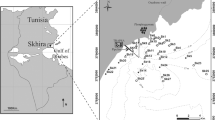Abstract
Five species assemblages of the intertidal infauna of Old Tampa Bay, Florida, USA are identified. Two assemblages are judged to constitute distinct communities, while a third is shown to be an interdigitation of the two communities. Dominance by on species is the prevalent pattern within the assemblages. Numbers of deposit feeders are found to be inversely correlated to that of filter feeders, and both trophic types are found to be correlated to the sediment parameters of median grain size, sorting and skewness. Three transects with three stations each were established along the south side of Courtney Campbell Causeway in Tampa Bay, Florida. A faunal sample (0.4 m2), a sediment sample, and a water sample were taken at each station in September, December, and March of 1968/1969. Sediment samples were wet-seived. Animal samples were reduced to numbers of organisms and biomass per species. Trellis diagrams and correlation tests were generated. Support is shown for the trophic group-amensalims hypothesis, however, the silt-clay fraction is apparently of lesser importance to deposit feeders in Florida sediments than in Buzzards Bay sediments. An attempt is made to relate an analysis of the optimal grain size for filter feeders to the trophic group-amensalism hypothesis. A view of communities as abstractions from continua is more realistic than communities as discrete units.
Similar content being viewed by others
Literature cited
Barnes, R. D.: Invertebrate zoology, 743 pp. Philadelphia: W. B. Saunders Co. 1964.
Dixon, W. J.: BMD biomedical computer programs, Berkeley: University of California Press 1967.
Dragovich, A. and G. A. Kelly, Jr.: Ecological observations of macroinvertebrates in Tampa Bay, Florida 1961–1962. Bull. mar. Sci. Gulf Caribb. 14 (1), 74–102 (1964).
Green, R. H. and K. D. Hobson: Spatial and temporal structure in a temperate intertidal community, with special emphasis on Gemma gemma (Pelecypoda: Mollusca). Ecology 51 (6), 999–1011 (1970).
Horn, H. S.: Measurements of “overlap” in comparative ecologicalstudies. Am. Nat. 100 (914), 419–423 (1966).
Johnson, R. G.: Variations in diversity within benthio marine communities. Am. Nat. 104 (937), 285–300 (1970).
Krumbein, W. C.: Applications of logarithmic moments to size frequency distribution of sediments. J. sedim. Petrol. 6 (1), 35–47 (1936).
Macfadyen, A.: Animal ecology. Aims and methods, 344 pp. London: Sir Issac Pitman and Sons, Ltd. 1963.
MacGinite, G. E. and N. MacGinite: Natural history of marine animals, 523 pp. New York: McGraw-Hill 1968.
McIntyre, A. D. and A. Eleftheriou: The bottom fauna of a flatfish nursery ground. J. mar. biol. Ass. U.K. 48 (1), 113–142 (1968).
McNulty, J. K., R. C. Work and H. B. Moore: Some relationships between the infauna of the level bottom and the sediment in South Florida. Bull. mar. Sci. Gulf Caribb. 12 322–332 (1962).
Mills, E. L.: The community concept in marine zoology, with comments on continua and instability in some marine communities: A review. J. Fish. Res. Bd Can. 26 (6), 1415–1428 (1969).
Moore, H. B., L. T. Davies, T. H. Fraser, R. H. Gore and N. R. Lopez: Some biomass figures from a tidal flat in Biscayne Bay. Fla Bull. mar. Sci. 18 (2), 261–279 (1968).
Morisita, M.: Measuring of interspecific association and similarity between communities. Mem. Fac. Sci. Kyushu Univ. (Ser. E.) 3, 65–80 (1959).
Paine, R. T.: Ecology of the brachiopod Glottidia pyramidata. Ecol. Monogr. 33, 255–280 (1963).
Reish, D. J.: A discussion of the importance of screen size in washing quantitative marine bottom samples. Ecology 40 (2), 307–309 (1959).
Rhoads, D. C. and D. K. Young: The influence of deposit feeding organisms on sediment stability and community trophic structure. J. mar. Res. 28 (2), 150–177 (1970).
Sanders, H. L.: Benthic studies in Buzzards Bay I. Animalsediment relationships. Limnol. Oceanogr. 3, 245–258 (1958).
—: Benthic studies in Buzzards Bay III. The structure of the soft-bottom community. Limnol. Oceanogr. 5, 138–153 (1960).
—, E. M. Goudsmit, E. L. Mills and G. E. Hampson: A study of the intertidal fauna of Barnstable Harbor, Mass. Limnol. Oceanogr. 7 (1), 63–79 (1962).
Stephenson, W., W. T. Williams and G. N. Lance: The macrobenthos of Moreton Bay. Ecol. Monogr. 40 (4), 459–494 (1970).
Taylor, J. L., J. R. Hall and C. H. Saloman: Mollusks and benthic environments in Hillsborough Bay, Florida. Fish. Bull. U.S. 68 (2), 191–202 (1971).
Thorson, G.: Bottom communities, Chapter 17. In: Treatise on marine ecology and paleoecology. Vol. 1 Ecology, pp 461–534. Ed. by J. W. Hedgpeth. Mem. geol. Soc. Am. 67, 461–534 (1957).
Author information
Authors and Affiliations
Additional information
Communicated by J. Bunt, Miami
Rights and permissions
About this article
Cite this article
Bloom, S.A., Simon, J.L. & Hunter, V.D. Animal-sediment relations and community analysis of a Florida estuary. Marine Biology 13, 43–56 (1972). https://doi.org/10.1007/BF00351139
Accepted:
Issue Date:
DOI: https://doi.org/10.1007/BF00351139




